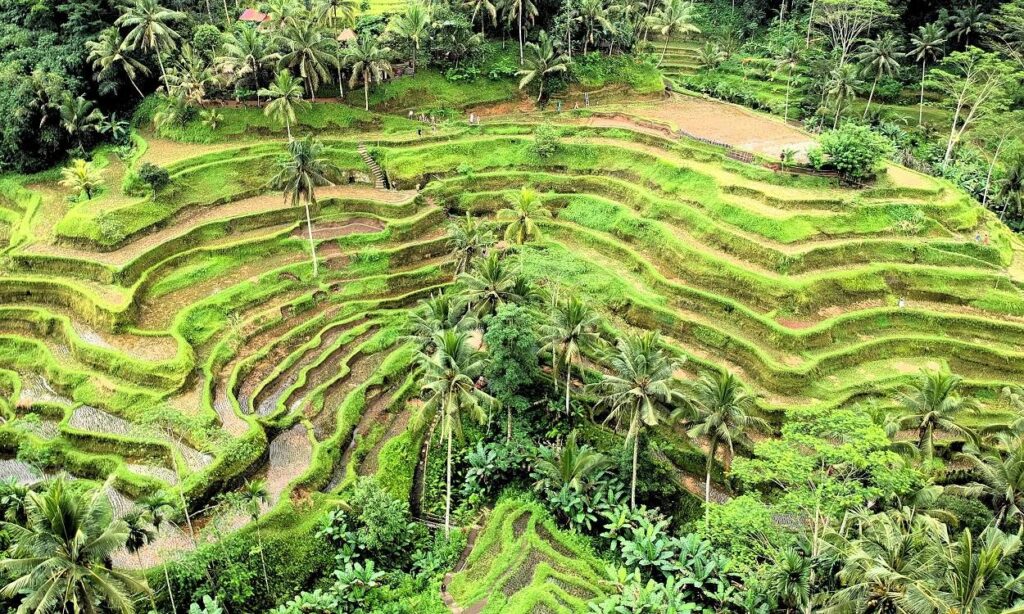Nestled in the heart of Bali’s lush landscape, Ubud is a haven for enthusiasts of sustainability and nature lovers alike. The town embodies a deep connection with the land, inviting travellers to embrace Slow Living and take part in regenerative practices that honour Bali’s agricultural traditions.
In Ubud, you’ll be drawn to the principles of Permaculture Bali, an approach that integrates sustainable farming with ecological harmony. Inspired by local wisdom and the stunning landscapes of Tegallalang Rice Paddies, you can embark on a journey to create your own permaculture garden—a sanctuary for food cultivation, biodiversity, and personal reflection. If you’re considering starting your own permaculture garden in Ubud, here’s a guide to help you bring your vision to life.
Step 1: Understanding Permaculture in the Balinese Context

Before diving into design and planting, it’s essential to understand how permaculture fits within Bali’s agricultural landscape. Unlike conventional farming, permaculture focuses on working with nature rather than against it. The philosophy is built on three key ethics: care for the earth, care for people, and fair share.
One of the best ways to gain insight into Bali’s agricultural traditions is by joining Bali cultural tours, where local farmers share their wisdom on traditional irrigation systems such as subak. This ancient method, seen in the breathtaking Tegallalang Rice Paddies, emphasises community cooperation and water conservation—principles that can be integrated into your own permaculture garden.
Step 2: Choosing the Right Location
Selecting a suitable site is crucial for creating a successful permaculture garden. Ideally, you’ll want an area with ample sunlight, access to water, and good soil quality. If you’re lucky enough to be based in Ubud, you’ll find the volcanic soil to be incredibly fertile, supporting a wide range of crops.
Consider the following factors when choosing your location:
- Sun Exposure – Most food-producing plants thrive with plenty of sunlight, so ensure your garden gets adequate light throughout the day.
- Water Sources – Look for nearby streams or natural water systems to incorporate sustainable irrigation techniques.
- Microclimate Awareness – Ubud’s tropical climate means frequent rains, so plan for proper drainage to prevent waterlogging.
Once you’ve found the perfect site, spend time observing the land—how the water moves, where the shade falls, and what existing vegetation thrives. Permaculture is all about working with natural patterns, so taking time to understand your space is invaluable.
Step 3: Building Healthy Soil

Healthy soil is the foundation of any successful permaculture garden. Instead of relying on chemical fertilisers, the goal is to create rich, organic earth that nourishes your crops naturally.
One of the best places to source organic compost is the Organic Farmers Market in Ubud, where local growers sell nutrient-rich fertilisers made from kitchen scraps, coconut husks, and plant matter. Incorporating these natural amendments into your soil will enhance fertility and promote beneficial microorganisms.
In addition, consider techniques such as:
- Mulching – Cover bare soil with dried leaves, straw, or coconut fibres to retain moisture and prevent erosion.
- Composting – Set up your own compost pile to recycle kitchen waste into organic fertiliser.
- Nitrogen Fixing Plants – Grow legumes such as peanuts or beans to naturally replenish soil nutrients.
By prioritising soil health, you’re creating an ecosystem that can support a thriving garden without harmful chemicals.
Step 4: Designing Your Permaculture Garden
With a strong foundation in place, it’s time to design your garden using permaculture principles. The key is to create a system where different plants, animals, and natural elements work together in harmony.
Companion Planting
Instead of planting monocultures, mix complementary crops together to enhance growth and repel pests. For example:
- Basil planted alongside tomatoes improves flavour and deters insects.
- Banana trees provide shade for delicate herbs like coriander.
- Chilli peppers act as a natural pest deterrent.
Water Conservation Techniques
Bali’s humid climate offers abundant rainfall, so making the most of this natural resource is key. Install rainwater collection systems or use swales—shallow channels that direct water flow—to ensure efficient irrigation.
Vertical Gardens
If space is limited, make use of vertical structures to grow climbers like beans, cucumbers, and passionfruit. This method maximises yield while reducing soil compaction.
By thoughtfully designing your garden layout, you’ll create a space that mimics natural ecosystems while providing an abundance of fresh produce.
Step 5: Growing and Harvesting Your Own Food

One of the most rewarding aspects of permaculture gardening is growing your own food. As someone passionate about local Balinese flavours, I wanted to cultivate ingredients commonly used in a Bali cooking class—lemongrass, turmeric, kaffir lime, and galangal.
Here are some easy-to-grow plants suited for Bali’s climate:
- Tropical Fruits – Mango, papaya, passionfruit, and bananas thrive in Ubud’s warm environment.
- Herbs & Spices – Basil, ginger, turmeric, and coriander add depth to local dishes.
- Leafy Greens – Water spinach, kangkung, and amaranth are nutritious and easy to grow.
Harvesting your own food isn’t just about sustainability—it connects you with the land in a way that deepens appreciation for every meal.
Step 6: Integrating Animals into Your System
Permaculture gardens benefit from natural biodiversity, which includes animals. Whether it’s free-ranging ducks helping with pest control or compost worms enriching the soil, each creature plays a vital role.
Consider incorporating:
- Chickens – Great for fertilising soil and producing fresh eggs.
- Bees – Essential for pollinating fruit-bearing plants.
- Fishponds – Can be used for aquaponics, where fish waste provides nutrients for crops.
Embracing a holistic approach ensures a thriving garden where nature maintains balance.
Final Thoughts: Living in Harmony with the Land
Creating a permaculture garden in Ubud isn’t just about growing food—it’s about adopting a mindset that respects nature’s rhythms. It’s a way to engage with the environment, learn from local traditions, and experience the joy of self-sufficiency.
In Ubud, where sustainability and creativity intertwine, the land itself is a teacher. Whether you’re tending to a humble plot or dreaming of a large-scale food forest, every seed planted is a step towards regenerative living.
If you find yourself here, don’t just observe—get involved. Join a cultural tour, take a cooking class, visit the organic market, and, most importantly, let the land guide you. Ubud offers more than scenic beauty; it provides lessons in patience, respect, and the infinite artistry of nature.

